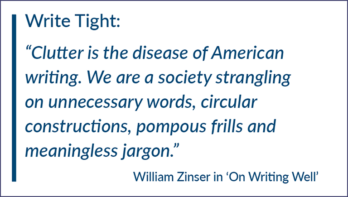In graduate school, I rarely had an exam. My work was in journalism, and we were required to write extensively, then graded for the course on that writing. I had one professor in particular who used ink the color of blood, and he covered every available space with comment—mostly criticisms—giving the pages an eerie, sanguine look.
Stein on Writing (St. Martin’s Press, 1995) by Sol Stein, author of nine novels and editor of such notables as Bernard Baruch and Lionel Trilling. This book is especially helpful for editors who subscribe to the idea of the editor as coach, i.e., the editor’s job is to teach the writer how to improve his or her writing, not do it for the writer.
These professors believed, as I do now, that writing is the core skill for everyone in the publishing field. Every editor should be able to write well-constructed sentences and string them together in coherent paragraphs. With this in mind, I recommend
I’ve often said that you don’t learn to write by reading a book on writing. You learn to write by writing, by practice. Besides, most books on writing, with some notable exceptions—e.g., Rita Mae Brown—say the same things. They just arrange the content differently. This one, however, is unusual.
Stern sets out his purpose in chapter one: “This is a book of usable solutions—how to fix writing that is flawed, how to improve writing that is good, and how to create interesting writing in the first pace.” I found the first “usable solution” in chapter one where Stein explores the difference between fiction and non-fiction.
Non-fiction, he says, conveys information; fiction evokes emotion. The problem is that so-much non-fiction seems pedestrian, a dry recitation of facts or concepts. And, today, especially because of the images we’re surrounded with, readers get bored quickly with a lot of non-fiction. So good non-fiction writers are borrowing techniques from fiction to make their material more inviting. They use narrative, dialogue, drama, conflict, suspense, tension, and development of characters, all to evoke emotion in the reader.” In journalism,” says Stein, “the change has been revolutionary.” Still, non-fiction stems from fact and it must not depart from this. “It can make us feel what happened, but it must not invent what happened.
His chapter on beginnings, “Come Right In,” treats a common topic with many helpful examples. His chapter on imagery—although I don’t think he ever uses the word—spells out the difference between writing in the nineteenth and twentieth centuries. Again, due to the rise of images all around us, “twentieth century audiences,” Stein insists, “now insist on seeing what they are reading.” And there has been a “corresponding decrease in description of indoor and outdoor places that put the story on hold, making twentieth-century readers start to skip.”
Stein’s book has received high recommendations from the likes of Lionel Trilling and Elia Kazan, both of whom he edited. You’ll get much more than your money’s worth in professional help.
— by Ron Wilson
Wilson is a former executive director of EPA.





